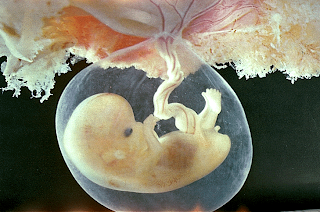
embryo
- Researchers have discovered how to transform human embryonic stem cells into germ cells. The advance will allow researchers to observe human germ cells
- "Although infertility is apparent only after sexual maturity, many forms of unexplained infertility are thought to have their origins in errors that occur in the cells of the early embryo. The ability to observe embryonic germ cells as they develop may allow researchers to pinpoint potential genetic changes underlying infertility." -Dr. Feijo Pera
- The researchers began with human embryonic stem cells, to which they added a gene that makes a protein which flashes green when a gene found only in germ cells is turned on. After the embryonic stem cells grew and changed for two weeks, the researchers isolated the cells that flashed green
- The researchers even observed that some male germ cells went all the way through the process of meiosis, to the point where they had half as much genetic material as they had begun with
- Dr. Reijo Pera next plans to try the same techniques with induced pluripotent stem cells
Reflection:
I chose this story because it tells about actual research on stem cells. It isn't just an article telling about stem cells, but it's an actual experiment. I thought this article was interesting because the researchers were able to discover something they had been trying to figure out for a while. I think that if anyone was interested in science, or interested in stem cell research, should read this article so that they know what is going on with stem cell research.
"NIH-Funded Researchers Transform Embryonic Stem Cells Into Human Germa Cells."NICHD - The Eunice Kennedy Shriver National Institute of Child Health and Human Development Official Home Page. 28 Oct. 2009. Web. 17 May 2010. http://www.nichd.nih.gov/news/releases/102809-germ-cell.cfm
Can you tell me where you got this image? I would like to use it if possible.
ReplyDelete